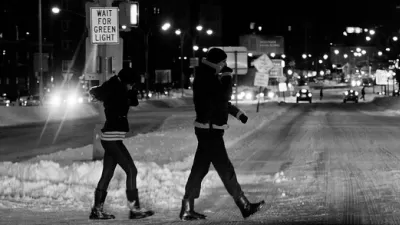Traffic deaths dropped by 27 in 2015 to 230, a reduction of over 10 percent from 2014. Pedestrian deaths decreased only slightly. Bicyclists fared better: deaths dropped by 30 percent.
"Even though such deaths declined, city officials and traffic-safety groups agreed that more aggressive steps must be taken to reach Mayor Bill de Blasio’s goal of eliminating traffic deaths in the city by 2024, as part of a plan called Vision Zero that he announced nearly two years ago," writes Emma G. Fitzsimmons of The New York Times.
"Pedestrian deaths, which account for the largest share of the fatalities, dropped slightly last year after reaching a historic low in 2014," adds Fitzsimmons. The 133 recorded fatalities amounts to 58 percent of total traffic deaths.
In 2015, 133 pedestrians died in traffic crashes, according to city data, though officials cautioned that the figures could change after the cases were more closely examined. Last January, the city reported 132 pedestrian deaths for 2014, but that number later rose to 139 — still the lowest total on record and down significantly from 183 deaths in 2013.
The Vision Zero program enters its third year with the strong backing of Mayor Bill de Blasio.
“We are moving in the right direction,” the mayor said in an interview. “We know there is a lot more to do, but there is no question that Vision Zero is working.”
A few bullet points on how the program, which featured various safety improvements, such as "lowering the default speed limit to 25 miles per hour" (See NYC Vision Zero Action Plan for more details), fared in 2015.
- Traffic deaths are down in every borough with one notable exception: Staten Island.
- Greatest reduction in traffic deaths occurred for those riding on two wheels:
- Bicycle fatalities dropped by 30 percent, from 20 to 14.
- Motorcyclists saw the greatest improvement: deaths reduced by over 40 percent, from 37 to 22.
- No change for those riding in motor vehicles: 61 deaths.
Fitzsimmons writes that Vision Zero is "modeled after a Swedish approach that treats all road deaths and serious injuries as inherently preventable." An accompanying photo shows the traffic-safety group Families for Safe Streets, marching in November carrying signs stating, "I pledge to use 'Crash not Accident'" to reinforce the preventable nature of traffic injuries and fatalities. The message on their "pledge" webpage:
Traffic crashes are fixable problems, caused by dangerous streets and unsafe drivers. They are not accidents. Let’s stop using the word "accident" today.
FULL STORY: Number of Traffic Deaths in New York Falls for a Second Straight Year

Study: Maui’s Plan to Convert Vacation Rentals to Long-Term Housing Could Cause Nearly $1 Billion Economic Loss
The plan would reduce visitor accommodation by 25,% resulting in 1,900 jobs lost.

North Texas Transit Leaders Tout Benefits of TOD for Growing Region
At a summit focused on transit-oriented development, policymakers discussed how North Texas’ expanded light rail system can serve as a tool for economic growth.

Why Should We Subsidize Public Transportation?
Many public transit agencies face financial stress due to rising costs, declining fare revenue, and declining subsidies. Transit advocates must provide a strong business case for increasing public transit funding.

How to Make US Trains Faster
Changes to boarding platforms and a switch to electric trains could improve U.S. passenger rail service without the added cost of high-speed rail.

Columbia’s Revitalized ‘Loop’ Is a Hub for Local Entrepreneurs
A focus on small businesses is helping a commercial corridor in Columbia, Missouri thrive.

Invasive Insect Threatens Minnesota’s Ash Forests
The Emerald Ash Borer is a rapidly spreading invasive pest threatening Minnesota’s ash trees, and homeowners are encouraged to plant diverse replacement species, avoid moving ash firewood, and monitor for signs of infestation.
Urban Design for Planners 1: Software Tools
This six-course series explores essential urban design concepts using open source software and equips planners with the tools they need to participate fully in the urban design process.
Planning for Universal Design
Learn the tools for implementing Universal Design in planning regulations.
City of Santa Clarita
Ascent Environmental
Institute for Housing and Urban Development Studies (IHS)
City of Grandview
Harvard GSD Executive Education
Toledo-Lucas County Plan Commissions
Salt Lake City
NYU Wagner Graduate School of Public Service





























